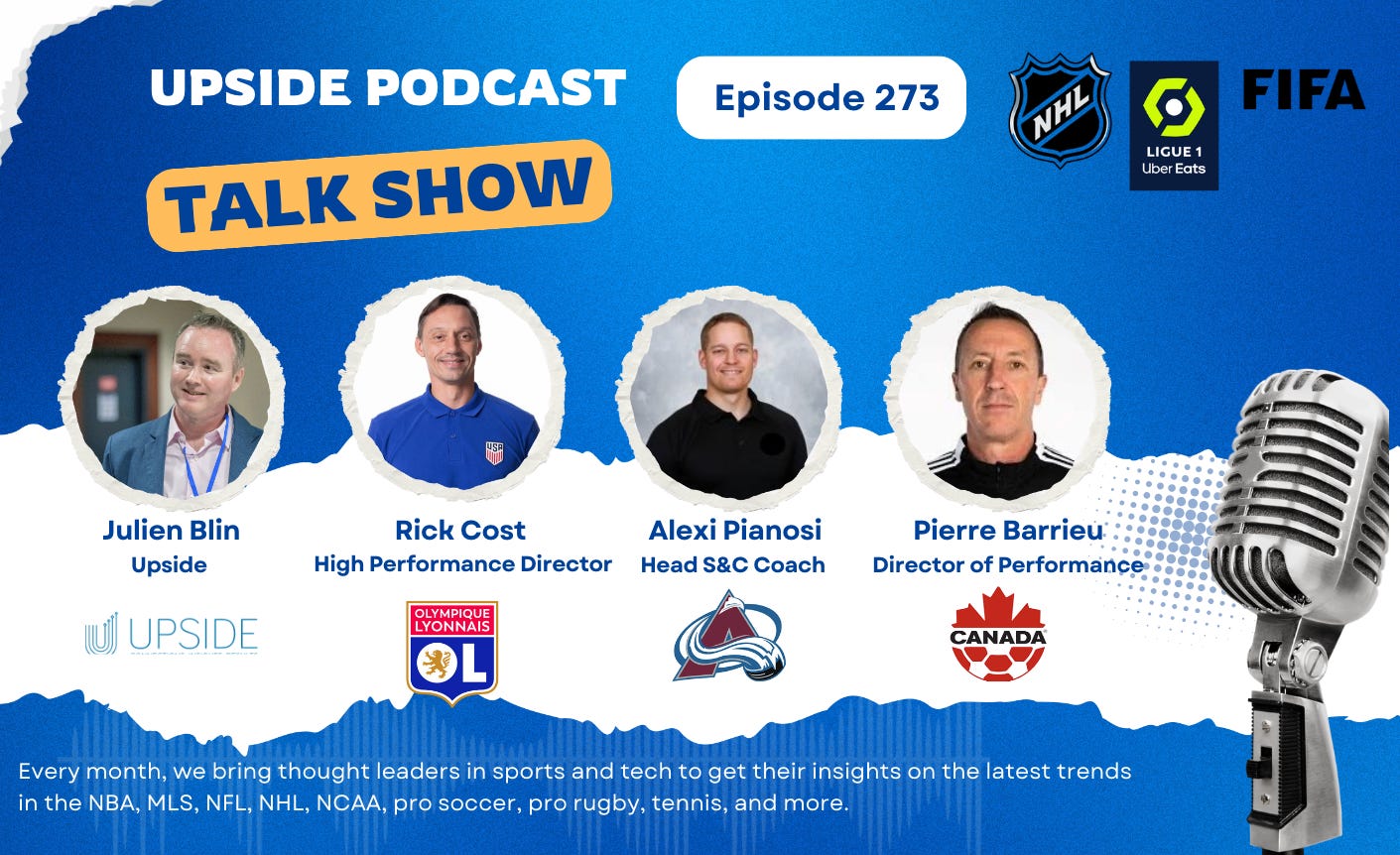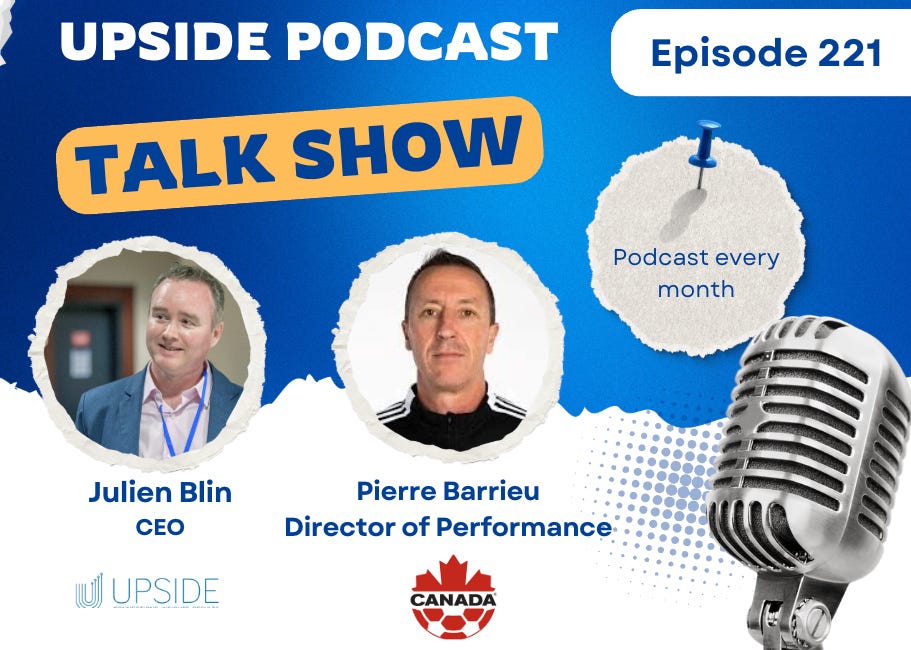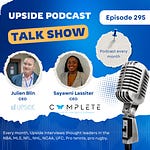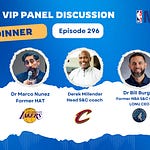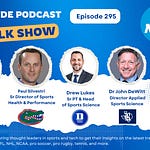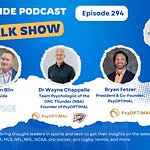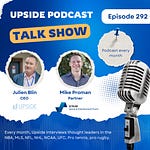This week we had the honor to interview again a group of sports performance experts (NHL, FIFA, Ligue 1).
Pierre Barrieu, the director of performance for the Canadian men national soccer team.
Alexi Pianosi, the head S&C coach for the Colorado avalanche (NHL team).
Rick Cost, the High Performance Director at l’Olympique Lyonnais (Ligue 1).
You can watch the video interview below by clicking on the Youtube link. You can also listen to the audio interview by clicking on the link at the top of the page:
📝Show Notes: Through this interview, we touched on:
Resistance training trends
Physical therapy innovations
Recovery modalities in practice
Leveraging diverse expertise
You can read the full transcript of the podcast interview located at the top of this blog post.
Here are some of the best quotes of our conversation with them:
1. Resistance Training Trends
Rick Cost:
“What we try to do is sort of a healthy mix, but it starts most of all with microdosing on a daily basis. It’s not about doing massive strength sessions, because in Europe the most important moment of the day is being on the football field. No training should ever negatively influence movement quality on the field. We use flywheel training mostly for its eccentric braking power and the timing of different movements. But the keyword for us is microdosing—lots of small, functional implementations. Then on an individual level, we target more specific needs—sometimes hypertrophy, sometimes isometric work, sometimes dynamic work like sprinting, which itself can be considered power training. So it’s very individual, very functional, but always built around the concept of microdosing.”
Alexi Pianosi:
“These technologies—whether it’s isokinetics, flywheels, or velocity-based training—have given us a variety of ways to approach the process and tailor the stimulus more specifically, and perhaps more safely, with less guesswork. You can put a Tendo unit on a bar and check if the load is moving at the right speed, but some of these systems allow you to skip steps and customize the load exactly to what you want. It’s new tools on an old process—we’re still chasing hypertrophy, motor unit recruitment, and power, the same things coaches have talked about for decades. But now we can do it more efficiently. The key, though, is not getting distracted by the shiny new toy. Too many practitioners jump on technologies just because they’re new or cool, not because they solve a problem. If you don’t start with the problem and then find the solution, you’ll just bounce from product to product and never really move forward.”
Pierre Barrieu:
“In my career, only once have I actively looked for a technology to fill a specific gap. Most of the time, I’ve discovered tools through colleagues, not vendors. You want equipment that meets a need, but you also want buy-in from players—because if they don’t use it, it doesn’t matter how good it is. Sometimes a tool only works for two or three players, and that’s fine. To me, that’s also microdosing—individualizing interventions so they have meaning. Too often people buy equipment just because another team has it, or because a GM says, ‘Look at this.’ That’s risky. Players aren’t blind—they see when tech gets bought and then collects dust in the corner of the gym. So for me, the decision comes down to: does it solve a problem we actually have, and will the players buy into it?”
2. Physical Therapy Innovations
Pierre Barrieu:
“There used to be almost a race to get players with ACL injuries back on the field in six months. But the reality is, most of them ended up injured again at seven. Now the accepted return is closer to nine months, which is what it always should have been. For me, that’s the biggest innovation—not a new gadget, but a rational, science-based respect for biology. You still hit the same KPIs, you still progress step by step, but over a safer timeline. Unless surgical techniques themselves change, the real progress has been in communication, and in getting coaches and organizations to accept that biology doesn’t care about your season schedule.”
Rick Cost:
“I think the biggest innovation isn’t a machine or modality, but a cultural one. There’s more respect for practitioners and more understanding from coaches. Ten years ago people tried to push ACL return-to-play to five or six months. Now coaches understand that nine months is what’s realistic. The same with hamstrings—people used to think a player could be ready in a few days, but now there’s more understanding of location, history, and the individual context. That shift in communication and respect has changed rehab more than any technology has.”
Alexi Pianosi:
“The real improvements in rehab come from understanding that what you do in month one and two matters more than what you do in month seven. We used to keep players at home for weeks after surgery, but now we know the quality of tendon starts degrading almost immediately if you don’t move. So we get people moving right away—in the pool, with small exercises—because that’s what helps us truly shorten the timeline. As for modalities, most of them just promote blood flow. Whether it’s BFR, compression, or stim, they’re all basically trying to deliver oxygen and remove waste. The key is matching the modality to your environment. For us, with long flights, it’s compression boots, stim, or recovery shoes, because we need to combat hours of sitting still. For another team, it might be circadian tools for crossing time zones. It’s less about reinventing the wheel, more about finding the right fit for your specific context.”
3. Recovery Modalities in Practice
Alexi Pianosi:
“Most recovery tools—cryotherapy, compression, BFR—they all do the same basic thing: promote blood flow. The real question isn’t which tool is the flashiest, but which one addresses the challenges of your environment. For us, we spend more time in the air than most teams, so compression and electrical stimulation make sense to combat immobility. If you’re a team that constantly changes time zones, maybe it’s circadian rhythm strategies. It’s about pairing the right tool with the problem you actually have, not buying everything because it looks good.”
4. The Human Side of the Role
Rick Cost:
“People still call me the ‘warm-up guy,’ but that couldn’t be further from reality. My job is strategy, budgets, individual development plans, and making sure the structure is in place for specialists to do their jobs. At big clubs, you might oversee 30 to 70 people. You rarely touch players directly anymore. That’s what’s misunderstood about the role—it’s much more executive and managerial than people realize.”
Alexi Pianosi:
“The hardest part is the sheer amount of time. You’re at the facility hours before and after players, you’re on the road constantly, and even in the off-season you don’t really get time off. The pressure is challenging, but in a way it’s fun—that’s why you sign up for pro sports. The real cost is time away from family, from friends, from living any sort of normal life. Charter flights and fancy meals are exciting for a year, but eventually you just miss being at home on the couch with people you care about. That’s the side most people don’t see.”
Pierre Barrieu:
“The biggest challenge for me is federating a diverse group of specialists around the same project—giving them freedom, responsibility, and respect, but also leading them. In national teams, it’s easier. In clubs, it’s the grind: the hours, the toll on families, the constant need to coordinate people from different areas and avoid frustration. The only way it works is if you put experts in positions of responsibility, sometimes people who know more than you, and then coordinate the whole machine so it functions daily. That’s the part people don’t see.”
5. Leveraging Diverse Expertise
Pierre Barrieu:
“At the end of the day, it’s about people. Assemble good characters first, because the real test comes when results dip. Never too high when you win, never too low when you lose—that applies to staff as much as players. Cultural context matters too: in some countries you can raise your voice, in others it’s counterproductive. If you don’t adapt to the cultural context of your staff and players, you set yourself up for failure. That’s something leaders often underestimate.”
Alexi Pianosi:
“With bigger staffs you’ll never have total harmony. You’ll always have disagreements, and that’s okay. The goal isn’t perfection, it’s progress. Real culture forms when standards are clear, vulnerability is allowed, and everyone is held accountable with care. If you can do that, you can handle disagreements, move on, and get ready for the next challenge. And in pro sports, there’s always another challenge—somebody tired, injured, or upset. If you acknowledge that imperfection is part of the process, you’ll build something resilient.”
Rick Cost:
“For me, the key is transparency and autonomy. Everyone should know their role and feel empowered to make decisions, not wait for me. The more accountability you give people, the more they enjoy their work, and the more they push themselves to deliver quality. In sport, there is no small job—because everyone’s work impacts everyone else. Finding the right people is half the battle. Once you do, you need to trust them, support them, and hold them accountable, so the whole group can function together.”
You may also like:
🔥Upside Chat with Mike Messer (Nashville SC / MLS), Rick Cost (US Soccer), Jason Han (Ex LAFC / MLS)
This week we have the honor to interview again a group of sports performance executives to talk about the latest trends in the world of sports performance and rehabilitation.
🔥Upside Chat with Pierre Barrieu (Canada Soccer), Adam Quigley (MLS/NFL), Alexi Pianosi (Colorado Avalanche/NHL) on Concussions, ChatGPT, the Offseason, Mbappe, and More.
This week we had the honor to interview again a group of sports performance experts.
🎙️ Upside Chat with Pierre Barrieu, Director of Performance (Canada Soccer) & UEFA Technical advisor & FIFA Freelancer
Today we have the honor of interviewing Pierre Barrieu, the director of performance for the Canadian national men soccer team, and a technical advisor for the UEFA and also works as a freelancer for the FIFA.


